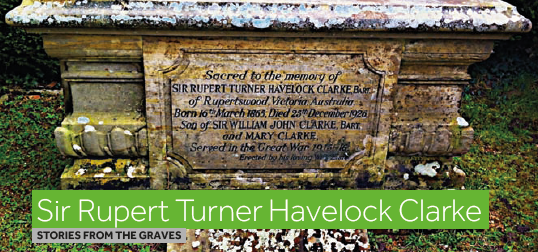
In the second of our features exploring the stories behind the graves at Walstead Cemetery we cross to Australia to delve into the life of Sir Rupert Turner Havelock Clarke.
Sir Rupert, a former owner of Old Place in Lindfield, led a colourful life, working as a sheep farmer, entering politics, becoming governor of the Colonial bank of Australia as well as pursuing a range of business interests from running a rabbit cannery to gold mining. He also owned a string of successful race horses…
By Claire Cooper
Sir Rupert Turner Havelock Clarke, 2nd Baronet of Rupertswood, pastoralist and entrepreneur, was born on 16 March 1865 at Rupertswood, Sunbury, Victoria.
He was the eldest son of Sir William John Clarke, the first holder of one of the few baronetcies existing in Australia, and his first wife Mary, née Walker. His grandfather was one of the pioneers of Victoria who arrived in Tasmania from Somerset in the early days of the colony.
Rupert was educated at Hawthorn Grammar School, Wesley College, Melbourne, and Magdalen College, Oxford, but took no degree.
In 1891, aged 21, he leased his father’s Cobran station, near Deniliquin, New South Wales, and later inherited the Sunbury properties of Bolinda Vale, Red Rock and Rockbank, totalling some 130,000 acres.
He sold these over a period, except for a reduced holding at Bolinda Vale and 800acres near Rupertswood named Kismet Park, on which, after the sale of Rupertswood to his brother Russell, he built a house.
Rupert successfully carried on his father’s stud, breeding English Leicester sheepand Derrimut Shorthorn cattle. As his holdings in Victoria diminished, he developed pastoral and other interests elsewhere, notably in Queensland, where he later owned Isis Downs in partnership with R. S. Whiting.
His adventurous spirit led him to conduct an expedition into the wilds of New Guinea and in 1895 he became one of the pioneer gold miners of Coolgardie in Western Australia.
Full article on pages 20/21.
